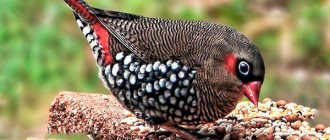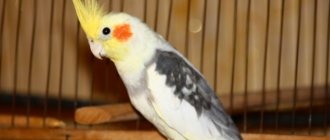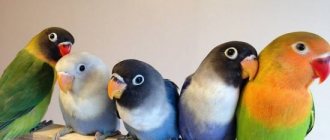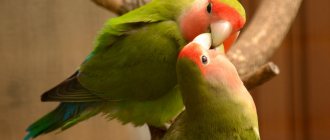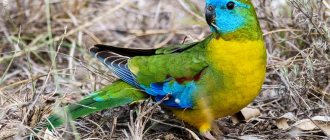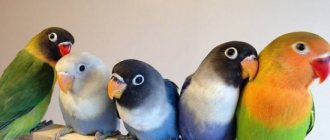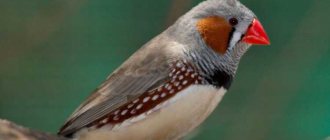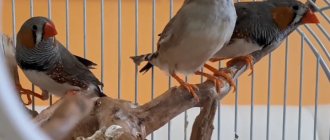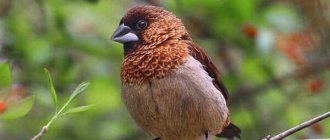More recently, in the first half of the 20th century, the finch bird was brought to Europe and Russia from hot countries. Outwardly fascinating and unpretentious in its breeding, it quickly won the hearts of poultry farmers. Today the finch is one of the most sought after ornamental birds in Russia.
To get a preliminary acquaintance with the bird, its habits and conditions of detention, just look at the photo and read the article below.
Small bird
The homeland of finches is the hottest continents: Africa and Australia. They also live in southern Eurasia and southern China.
In nature, as in captivity, they prefer to live in a school, or, in extreme cases, in pairs. They need partners and friends to actively spend time together - finches love to flutter, circle and jump from branch to branch.
Brothers in the order of our familiar sparrows and crows, finches are distinguished by their spectacular plumage that fits tightly to the body and a large “waxy” beak. Most species are small in size - from 10 to 12 cm in length, and very light - on average 13 g.
Note!
- Parrot: tips for choosing, the best breeds and rules for training different types of parrots (100 photos)
Eagle bird: description, species, lifestyle, habitat and interesting facts about the bird of prey (95 photos)
Parrot cage - features of choice
Amadins take their roots from the family of songbirds, and accordingly they are able to loudly make various sounds. Their spoken and singing vocabulary is very wide: from quacking and chirping to subtle artistic whistling.
Due to the laws of animals, loud singing and bright appearance predominate in male birds; female finches are quieter and inconspicuous in color.
How to distinguish a female from a male
There are several ways to distinguish a male from a female by appearance. Each of them requires separate mention.
By the beak
Males have larger beaks and are usually more brightly and deeply colored than females.
By color
The characteristic color characteristics of males and females differ in different species of finches. For example, male red-headed finches have a red head, which distinguishes them from females. The male zebra finch is gray but has a brown and white marking on the neck. They have a zebra pattern on their chest in the form of alternating white and black stripes. The color of the females is different from the color of the males.
By singing
Representatives of the stronger sex usually sing much better than females. Males do this beautifully and for a long time, sometimes performing complex compositions. The sounds made by females are usually abrupt and quiet. This can hardly be called singing at all. So if an individual sings well, it is almost certainly a male.
The owner must decide for himself how to distinguish a male from a female. It is advisable to use more than one method.
Getting to know the species
Ornithologists have counted about 40 species of finches and about 300 of their subspecies. The names most often explain the color or features of appearance - pearl or parrot finches; or bird habitat - Japanese and rice.
In addition to natural finches, there are species bred by breeders. Several types of birds have gained unprecedented popularity in domestication.
Diseases and prevention
Fragile finches are susceptible to specific diseases that are common to all birds. Among the characteristic avian diseases, psittacosis, internal tumors, and parasites are especially dangerous. Parrot finches also suffer from damage to the beak and feathers; They often have indigestion. Vitamin deficiency, baldness, injuries and poisoning are common phenomena in small birds, depending on the conditions of detention. To prevent complications, you should take care of your pets.
The biggest concern for owners is contagious diseases. Pet finches can pick up infections, mites, or fungi from new ones purchased at a pet store. Typical signs of a viral infection: changes in behavior, drowsiness, refusal to eat. But these same symptoms can be a manifestation of any other disease. If there is a suspicion that the pet is unwell, it is shown to the veterinarian. Reducing the likelihood of infection is easier than treating it, so quarantine is necessary for feathered newcomers.
Rice finch
Drawings are the largest finches. Their length reaches 18 cm and weight 25 g. The color of the plumage of rice finches is limited to a gray back and wings, a light brown belly and a black and white head with a red beak. Unlike previous representatives, females and males of the dandelion look the same.
The rice finch sings beautifully, iridescently and trills, sometimes interrupting it with loud cries. The song becomes longer and more varied if several individuals or a whole flock of creatures participate in a musical concert.
Risovka was originally a resident of the islands. The islands of Bali and Java can be considered its cradle. Later, the beloved bird was distributed to the mainland. In the vastness of Southeast Asia, the rice finch is considered an absolutely street bird, like the house sparrow in Russia.
Birds are ready to breed from the age of one year. The female and male build a nest together, take turns incubating the eggs and feeding the hatched chicks for another half a month.
It is impossible not to note the longevity of the drawings; with proper care, they can please the owner for more than 10 years.
Chinese sparrows
Representatives of this group are distinguished by their chocolate colored back, head and tail. The abdominal plumage is white.
The character is calm, unpretentious in care. Birds are very talkative, constantly making a lot of loud sounds, and sometimes you can hear singing.
Japanese finch
The list of the most domesticated finches ends with the Japanese finches. Inconspicuous compared to other species, it is colored brown above and gray below. This is the most common option, but there are also yellow and red birds, and with tufts on their heads.
The singing of Japanese finches resembles the squeaking of a rubber toy, and is quieter than that of most other finches. Only gentlemen sing.
The name explains the fact that the widespread distribution of this species came from Japan. Japanese finches are selectively bred. Today, due to its kind temperament, this type of bird has earned high marks from poultry farmers in Russia, Europe and America.
Japanese finches are often purchased in addition to other species as foster parents. They happily hatch the eggs of other finches and take care of abandoned chicks.
Buy poultry, prices
To choose a bird finch, you need to ask the seller to catch the individual you like for inspection. A healthy bird is moderately well-fed, the feathers are dense, without signs of mites and parasites. Health is also indicated by the clear springy movements of the finch and its booming voice.
Having spread the feathers, you should pay attention to the color of the skin. Normally it is light, slightly pinkish. A gray or yellow tint is a clear sign that the bird is sick.
How much finches cost will depend on:
- from sex (males tend to be more expensive),
- varieties,
- age,
- places of purchase.
The price for one individual starts from several hundred rubles.
Amadina for home
When purchasing a finch, you need to make sure that the bird is healthy according to the following parameters:
- normal weight,
- ringing voice
- sparkling eyes,
- light skin with a pink tint,
- absence of insect parasites.
You need to acquire two individuals of different sexes at once; alone, the finch will wither and die.
Birds are very timid; moving can literally scare them to death. Therefore, transportation should be carried out in a comfortable cage, hung with a dark cloth.
After purchase, it is advisable to submit the bird's droppings to a veterinary laboratory for the presence of parasites.
Taking care of your health
It is very important for a novice owner to become familiar with the description of the main diseases of finches, as well as treatment and prevention measures. The most important symptoms: loss of appetite, passivity, feather loss. However, if this is observed at the age of 1.6-3 months, then it is possible that the bird is experiencing its first moult. During this period, the diet is enriched with sprouted grains, vitamins and minerals.
Infectious diseases are fungal, parasitic and bacterial. A sick finch begins to hide its head under its wing, refuses food, but drinks a lot. The bird is placed in a quarantine cage, shown to a veterinarian and his recommendations are followed.
The main non-contagious disease is baldness (alopecia), associated with poor living conditions and iodine deficiency in the diet.
Note! Avocado, persimmon, green onions, dill are the cause of gastrointestinal diseases in birds. Feeding finches with these products is strictly prohibited.
Cell selection
Finches are very active birds that require a lot of space to keep them. At best, it's an enclosure. If this is not possible, you need to purchase the ideal cage for finches:
You need to choose a rectangular cage with a flat top. Its length should be twice the height and width. A couple of finches will be quite happy with a housing size of 40*20*25. During breeding and nesting seasons, birds will need more space.
The retractable tray is an important part for keeping birds. It makes cleaning the cage easy and safe.
The door for the human hand should be located at the bottom and close tightly so that the finch cannot fly out.
It is necessary to purchase additional cells. Proletnaya - for relocated young animals or molting females. Cages - for breeding and nesting of birds.
Lifespan in captivity
Japanese finches are the true long-livers of the feathered world, capable of living up to 10-15 years, however, provided they are well maintained. The birds were originally bred for domestic keeping, so in the wild they are not able to get their own food and will quickly die. To extend the life of your pets, you should create comfortable conditions for them:
- Temperature - from +20 degrees.
- The duration of daylight hours is from 12 hours, during the mating season it increases to 14 hours.
- Humidity - 60-70%.
Japanese finches are friendly, but you should be careful when introducing other birds to them; they must be non-aggressive individuals, otherwise injuries cannot be avoided.
Rules of care
In order for finches to feel comfortable at home, a person needs to remember that these birds love cleanliness and safety.
The first condition is to clean the cage every day, wash the feeders and drinkers. You need to immediately equip the cage in a practical way so that food and water do not get into each other during the day, and so that the birds cannot soil them with droppings.
Finches love water treatments; for this purpose, a bath with a small amount of water is installed in the cage in the morning. After bathing, the bathtub must be cleaned.
For the safety of finches, it is necessary to eliminate all possible causes of bird fright, because during it the bird begins to beat against the walls of the cage and may die from internal hemorrhage.
When the finch jumps, the cage, perches and housing fixtures should not make loud sounds. It is necessary to explain to children, if there are any in the apartment, that it is forbidden to take out birds, shout at them, or otherwise scare the birds. Also, protect the cage from access by cats and dogs.
A couple more care conditions include proper lighting and air temperature.
To ensure a 12-hour daylight hours, you need to resort to electric lighting sources.
The temperature in the finch's cage should not exceed 25°; overheating has a bad effect on the health and reproduction of birds.
Healthy finches live an average of one decade in captivity.
Historical data
The homeland of zebra finches is Australia. In this country, finches prefer to live in arid regions, while they constantly migrate in search of food. These unique birds live almost throughout the entire Australian continent. The settlement of these birds was facilitated by the development of agriculture and the improvement of gardens, pastures and fields located in areas with complex terrain, where forests had previously grown. In places where there is not enough drinking water, birds settle next to human habitation. They are not afraid of noise and screams, so they place their nests directly on the streets or inside any outbuildings.
Important point! Wild relatives are able to live without water for a week, so one can only be surprised at their endurance.
Even being in a cage, where there is always enough clean water, they silently drink it in unlimited quantities. During prolonged droughts, weaver finches always survive, and they can drink highly salted water without harm to their health. Many species of birds simply die after drinking salt water to relieve thirst.
Nutrition
The finch's diet should consist of 70% grain mixture (millet, flaxseed, meadow grass seeds, oatmeal). Additionally, it is useful for birds to be given a mash of boiled eggs, unleavened cottage cheese and crushed crackers.
A dish made from mealworms is considered a delicacy for finches. Powder made from dried insects and their larvae also qualitatively complements bird food.
For good health, finches should consume vegetables and fruits in any form every day. The exception is fruits rich in essential oils.
On the way to proper digestion of birds, there is daily mineral feeding, consisting of fine gravel, sand and crushed eggshells.
Breeding finches
In captivity, the best period for mating and nesting of finches is considered to be spring and the first half of summer.
After the poultry farmer prepares a cage or cage for nesting, and the correct selection of a pair of individuals, the breeding season begins for finches:
- Flirting with each other, followed by mating;
- Construction of a nest from material prepared by the owner;
- Laying and incubation of eggs lasts about 2 weeks.
- 2 weeks after the chicks appear, the female finch begins the second clutch, and the male takes care of the growing children.
- From the moment the chicks hatch until they are completely separated from their parents and feed on their own, 1 month passes.
Finches are not the easiest ornamental birds to breed, but if you devote the proper time and attention to caring for them, you can find a singing, beautiful friend for many years.

